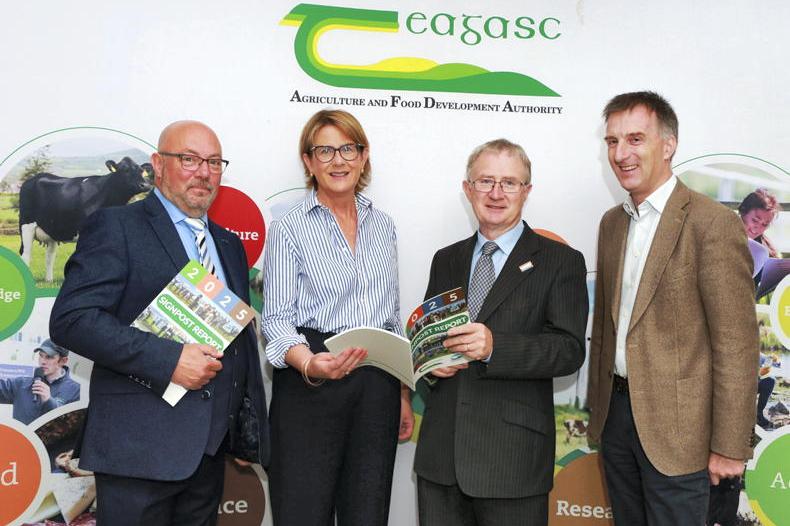Teagasc has found substantial improvements in soil fertility, with 70% of soils on Irish dairy farms being optimum for pH, P and K in 2024.
This figure comes from the Teagasc Signpost report 2025 launched on Wednesday, which has results from over 5,000 soil samples taken over the last four years.
The report also showed, through a deep-soil carbon campaign covering 91 farms, that Irish grasslands, particularly those on clay-rich soils, have strong potential to act as carbon sinks.
Teagasc director Prof Frank O’Mara said the report showed that farmers are not just willing, but are already taking action on climate change.
“The whole-of-industry approach has been invaluable and by combining scientific research with practical on-farm demonstrations, the Signpost programme is delivering results that matter, for farmers, for the environment and for Ireland’s climate goals.”
Signpost farmers
Improved nutrient use efficiency has contributed to a decline in overall fertiliser nitrogen (N) use, aided by greater incorporation of clover in swards, precision slurry application and enhanced nutrient planning.
Use of protected urea fertiliser has increased dramatically among Signpost farmers, with 76%, 58% and 69% of the chemical N applied on dairy, suckler beef and dairy beef farms respectively applied as protected urea, compared with a national average of less than 30%.
Over 90% of cattle farmers in the programme now use low emissions slurry spreading (LESS) methods.
In tillage systems, practices such as cover cropping, reduced fertiliser use and incorporation of organic manures have all seen increased usage across the programme.

The report also showed, through a deep-soil carbon campaign covering 91 farms, that Irish grasslands, particularly those on clay-rich soils, have strong potential to act as carbon sinks.
Head of the Signpost programme Dr Tom O’Dwyer added that climate action on farms is not only achievable but scalable.
“The enthusiasm of farmers to engage, adapt and lead is driving change across the country. These are practical steps with measurable impact, supported by evidence and collaboration.”
Behaviour
Teagasc said the programme represents a comprehensive effort to advance environmental stewardship in Irish agriculture.
This has been reflected in agricultural emissions having decreased by 1Mt CO2e (4.6%) since 2018.
Meanwhile, surveys from 2024 revealed that over 90% of Signpost demonstration farmers understand their farm’s emissions profile.
In addition, 77% of farmers attending Signpost events have implemented at least one emissions-reducing practice after attending Signpost events.
Read more
Why grass measuring is going to be more important
Protected urea and drop in finishing ages will help lower emissions – Teagasc
Teagasc has found substantial improvements in soil fertility, with 70% of soils on Irish dairy farms being optimum for pH, P and K in 2024.
This figure comes from the Teagasc Signpost report 2025 launched on Wednesday, which has results from over 5,000 soil samples taken over the last four years.
The report also showed, through a deep-soil carbon campaign covering 91 farms, that Irish grasslands, particularly those on clay-rich soils, have strong potential to act as carbon sinks.
Teagasc director Prof Frank O’Mara said the report showed that farmers are not just willing, but are already taking action on climate change.
“The whole-of-industry approach has been invaluable and by combining scientific research with practical on-farm demonstrations, the Signpost programme is delivering results that matter, for farmers, for the environment and for Ireland’s climate goals.”
Signpost farmers
Improved nutrient use efficiency has contributed to a decline in overall fertiliser nitrogen (N) use, aided by greater incorporation of clover in swards, precision slurry application and enhanced nutrient planning.
Use of protected urea fertiliser has increased dramatically among Signpost farmers, with 76%, 58% and 69% of the chemical N applied on dairy, suckler beef and dairy beef farms respectively applied as protected urea, compared with a national average of less than 30%.
Over 90% of cattle farmers in the programme now use low emissions slurry spreading (LESS) methods.
In tillage systems, practices such as cover cropping, reduced fertiliser use and incorporation of organic manures have all seen increased usage across the programme.

The report also showed, through a deep-soil carbon campaign covering 91 farms, that Irish grasslands, particularly those on clay-rich soils, have strong potential to act as carbon sinks.
Head of the Signpost programme Dr Tom O’Dwyer added that climate action on farms is not only achievable but scalable.
“The enthusiasm of farmers to engage, adapt and lead is driving change across the country. These are practical steps with measurable impact, supported by evidence and collaboration.”
Behaviour
Teagasc said the programme represents a comprehensive effort to advance environmental stewardship in Irish agriculture.
This has been reflected in agricultural emissions having decreased by 1Mt CO2e (4.6%) since 2018.
Meanwhile, surveys from 2024 revealed that over 90% of Signpost demonstration farmers understand their farm’s emissions profile.
In addition, 77% of farmers attending Signpost events have implemented at least one emissions-reducing practice after attending Signpost events.
Read more
Why grass measuring is going to be more important
Protected urea and drop in finishing ages will help lower emissions – Teagasc







 This is a subscriber-only article
This is a subscriber-only article










SHARING OPTIONS: